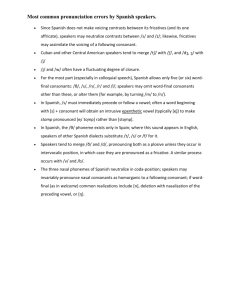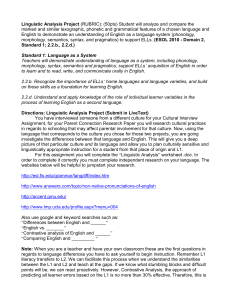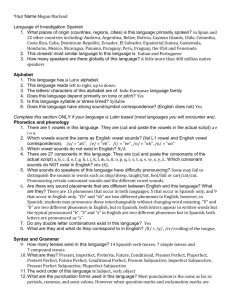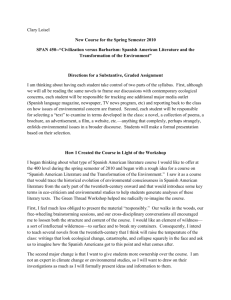Spanish linguistic analysis
advertisement
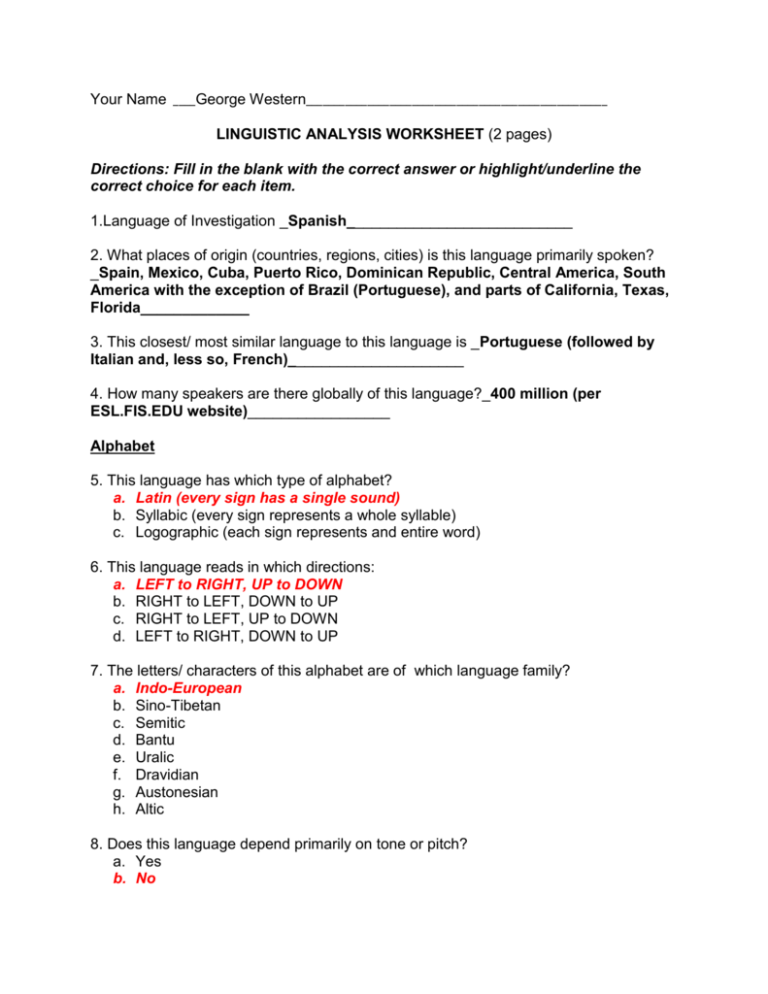
Your Name ____George Western______________________________________________________ LINGUISTIC ANALYSIS WORKSHEET (2 pages) Directions: Fill in the blank with the correct answer or highlight/underline the correct choice for each item. 1.Language of Investigation _Spanish___________________________ 2. What places of origin (countries, regions, cities) is this language primarily spoken? _Spain, Mexico, Cuba, Puerto Rico, Dominican Republic, Central America, South America with the exception of Brazil (Portuguese), and parts of California, Texas, Florida_____________ 3. This closest/ most similar language to this language is _Portuguese (followed by Italian and, less so, French)_____________________ 4. How many speakers are there globally of this language?_400 million (per ESL.FIS.EDU website)_________________ Alphabet 5. This language has which type of alphabet? a. Latin (every sign has a single sound) b. Syllabic (every sign represents a whole syllable) c. Logographic (each sign represents and entire word) 6. This language reads in which directions: a. LEFT to RIGHT, UP to DOWN b. RIGHT to LEFT, DOWN to UP c. RIGHT to LEFT, UP to DOWN d. LEFT to RIGHT, DOWN to UP 7. The letters/ characters of this alphabet are of which language family? a. Indo-European b. Sino-Tibetan c. Semitic d. Bantu e. Uralic f. Dravidian g. Austonesian h. Altic 8. Does this language depend primarily on tone or pitch? a. Yes b. No 9. Is this language syllable or stress timed? a. Syllable timed b. Stress timed 10. Does this language have strong sound/symbol correspondence? (English does not) a. Yes b. No Directions: Complete this section ONLY if your language is Latin based (most languages you will encounter are). Phonetics and phonology 11. There are ___5__ vowels in this language. 12. They are (cut and paste the vowels in the actual script) _/a/, /e/, /i/, /o/, /u/_. 13. Which vowels sound the same as English vowel sounds? (list L1 vowel and English vowel correspondence). _/a/ = /ah/, /e/ = /eh/, /i/ = /ee/, /o/ = /oh/, /u/ = /oo/_______ 14. Which vowel sounds do not exist in English? __none – there are actually 12 vowel sounds in English as opposed to 5 in Spanish_____ 15. There are ___22_____ consonants in this language. 16. They are (cut and paste the consonants of the actual script) _b, c, d, f, g, h, j, k, l, m, n, p, q, r, s, t, v, w, x, y, z_________________. 17. Which consonant sounds do NOT exist in English?_/ñ/ = /nyeh/ additionally, /b/ and /v/ are essentially the same sound in Spanish, and /h/ does not exist as a voiced consonant_. 18. What sounds do speakers of this language have difficulty pronouncing? Spanish L1 speakers have great difficulty with the complexity of English vowel sounds – they have 5 pure vowels, we have the same 5 vowels but 12 pure vowel sounds. According to the FIS article, and others, other issues include: /v/, such as in vowel or violin; ending consonants; adding a leading /e/ to words beginning with an /s/ consonant cluster; difficulty with pronouncing other consonant clusters. Another difficulty, because the sound does not exist in Spanish, is the voiced /h/. 19. Are there any sound placements that are different between English and this language? YES 20. What are they? (For example, _/b/ and /v/ are placed to produce a /bv/ sound; /ñ/ = /nyeh/ and the tongue comes off the back of the upper teeth; /h/ is not vocalized at all in Spanish; /j/ = /h/; /g/ sometimes = /h/ ______________________ 21. Do any double letter combinations exist in this language? __Yes, three (3)_ 22. What are they and what do they correspond to in English? (For example, Spanish: /ll/ = English /y/). /cc/ = English /ks/ ;/ll/ = English /y/; /rr/ = English /r/ rolled or trilled, i.e. “rrrrrrr”; also, rarely, /nn/ = English /n/ Syntax and Grammar 22. How many tenses exist in this language? 14, spread across indicative and subjunctive groups 23. What are they? Indicative group: Preterite Perfect, Preterite, Pluperfect, Imperfect, Present Perfect, Present, Future, and Future Perfect. Subjunctive group: Pluperfect, Imperfect, Present Perfect, Present, Conditional, Conditional Perfect (from .pdf retrieved from Spanish411.net) 24. The word order of this language is a. Verb, subject, object (VSO) b. Subject, verb, object (SVO) c. Object, verb, subject (OVS) d. Verb, object, subject (VOS) e. Subject, object, verb (SOV) f. Lacks a dominant word order 25 What are the punctuation forms used in this language? List using English comparisons. /¿ ?/ = English /?/ - used at beginning and end of a question. If the question occurs within a sentence, the question marks frame only the question itself / ¡ !/ = English /!/ - applied in the same way as question marks. Also sometimes used to frame a command. Special note – if a sentence contains both a question and an exclamation, it is permissible to use an exclamation at the beginning of the sentence and a question mark at the end. Commas and periods are used the same as in English, with the exception that it is common in Spanish to see a period in numerals where we would use a comma: example 10.000 for 10,000 (ten thousand in both cases). And, there are no “Harvard commas” in Spanish, i.e. you would not see one, two, and three….it would be uno, dos y tres. Long dashes are commonly used to denote a change in speaker in dialogue passages, replacing quotation marks. / « »/ = English /”…”/ - angled quotes in Spanish are used the same as Englishstyle quotation marks, with the exception that punctuation always goes outside the quotation marks. (About.com notes that the angled (« ») quotation marks are more commonly used in Spain; English style marks are more common in Latin America. 26. How does this language mark gender? Primarily via word endings. There are several rules (although as with most rules there are exceptions): #1 – masculine nouns generally end in /o/; feminine generally end in /a/ #2 – Nouns ending in –sion, -cion, -gion, -dad, -tad, -tud, e, z, and d are usually feminine #3 – Nouns ending in –ma, -ta, and –pa are usually masculine #4 – Nouns preceded by ‘la’ are feminine; nouns preceded by ‘el’ are masculine #5 – Some nouns, regardless of ending, can be either masculine or feminine depending on context. Examples: dentista – dentist, modelo - model Morphology 27. What are some shared cognates between English and this language? Artist / artista; tourist / turista; intelligence / inteligencia / mechanism / mecanismo; Activity / actividad; university / Universidad; impossible / imposible 28. What are some FALSE cognates between English and this language? Spanish asister (to be present) vs. English assist (to help) Spanish basamento (base of a column) vs. English basement Spanish bizzaro (brave) vs. English bizarre Spanish complexion (physique) vs. English complexion (facial skin tone) Spanish carpeta (briefcase or file folder) vs. English carpet 29. Through your research what have you found are the biggest difficulties of speakers of this language learning English? Please provide specific examples. First, understanding the added complexity of our vowel sounds. Spanish has 5 pure vowel sounds (one sound for each vowel), while we have at least two distinct sounds associated with each vowel. Example: /a/ = Spanish /ah/ vs. English /aye/, /aah/ as in apple, or /ah/ as in ah-ha Second, consonant sounds that do not exist in Spanish – primary example being the voiced /h/ as in hello (native Spanish speakers would not pronounce the /h/). Other examples would include our /v/ as in victor or violin, and /j/ as in jello (/j/ in Spanish is an English /h/). The above are the most difficult issues. Another issue presenting problems for Spanish speakers learning English is trouble with the stress-timed aspects of English (Spanish is syllable-timed and Spanish speakers tend to “level out” the stress patterns in English and thereby lose meaning. Also, as discussed in questions 27 and 28 above, there are enough cognates between English and Spanish to cause a false sense of familiarity, and therefore confusion, when false cognates are encountered. 30. If you have an early production ELL who this language is their L1, what would be the most important thing you will teach them in regards to the difference between their language and English? At this stage I would continue to stress the difference in vowel sounds and usage, since the multiple sound concept is completely foreign to them and still would be confusing even beyond the pre-production phase. This would include extensive de-coding work in individual or small group settings. We would also work on basic grammar/syntax issues. While English and Spanish are both primarily SVO-oriented languages, in Spanish there is a tendency to place important words at the end of a sentence for emphasis. Finally, I would start work with him/her on deciphering some of the more common false cognates.



